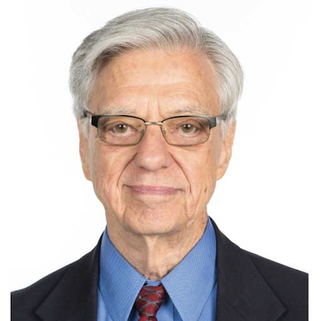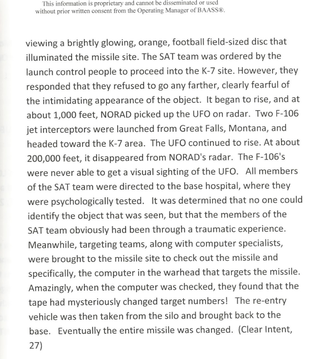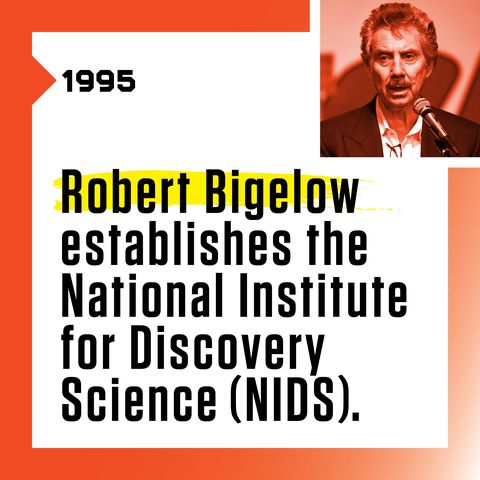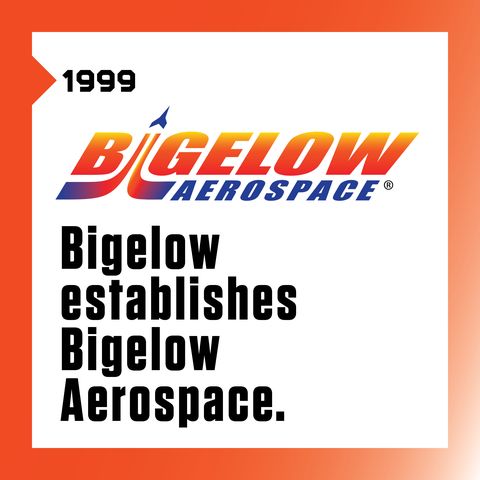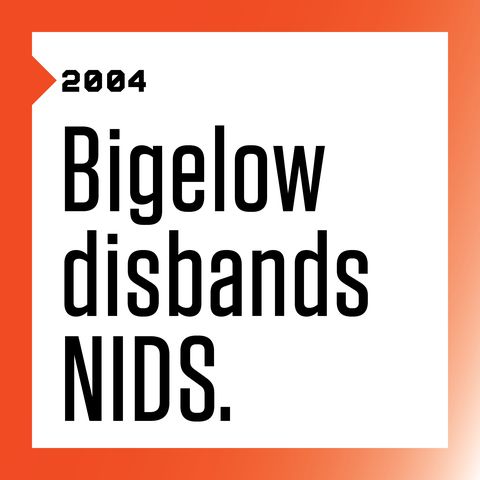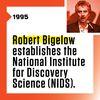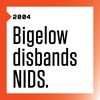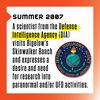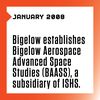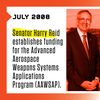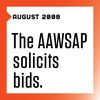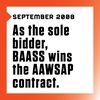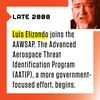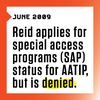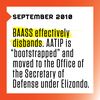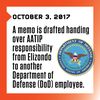Throughout the report, “the sponsor” is mentioned, however, the DIA is never explicitly named.
The first pages list the names of every contractor working for BAASS with appropriate security clearances to have access to the program. Amongst dozens of credentialed names, some of those listed are very familiar to the UFO community, including Puthoff, Davis, Jacques Vallee, and Colm Kelleher. Regardless of one’s existing opinions of the UFO phenomena, the sheer volume of content in the BAASS Ten Month Report is astounding.
● Plans to create a “medical physiological UAP effects program.”
● Request for Project Blue Book files that have not been made public.
● Mention of BAASS program dubbed “Project Northern Tier,” which involved securing documents related to instances where dozens of UFOs flew over restricted airspaces of facilities housing nuclear weapons.
● A possible UAP landing reported to BAASS by the Mutual UFO Network (MUFON) and its STAR Team (rapid response field investigators funded by BAASS in March 2009).
● Project databases of UAP-related materials compiled through various partnerships, and the intent to expand these databases by coordinating with foreign governments.
● Summaries of multiple UAP events both inside the U.S. and in foreign countries.
● Photographs of UAPs provided by various sources, including foreign governments.

Photograph of page 317 of the BAASS Ten Month Report.
From cover to cover, the BAASS report references the government’s new buzzword for UFOs: UAP. However, nowhere could Popular Mechanics find a single reference to foreign (terrestrial) advanced aerospace weapon systems, or projected technological innovations based on current industry trends.
Sources tell Popular Mechanics the BAASS Ten Month report was only a sample of the materials the organization provided to the DIA. “Monthly reports were being sent to the Pentagon, in addition to annual program updates, that were all about UAP or anomalous phenomena,” says one former BAASS contractor.
Chris Bartel, a security officer and investigator for BAASS (later Bigelow Aerospace) from 2010 to 2018, confirms the accounts of former BAASS and AATIP employees with Popular Mechanics. He says he indeed encountered some fairly dramatic paranormal events while working at the Skinwalker Ranch, and says he’d also heard mumblings of BAASS being interested in studying paranormal activity in hopes it could lead to technology research. However, Bartel says he didn’t know anything about AAWSAP or AATIP until last fall. “I was a bit taken back, to say the least,” he says.
Photograph of page 17 of the BAASS Ten Month Report.
BIGELOW AEROSPACE
Though unaware of any formal contract with the DIA, Bartel confirms that reports generated about paranormal events on the ranch were being faxed to both Bigelow and the Pentagon on a regular basis. (“I would hate to think my experiences up there were somehow manipulated by outside man-made forces,” Bartel says. “I truly believe the ranch to be hallowed Native land.”)
Some have suggested the “paranormal” events associated with Skinwalker Ranch or AAWSAP could be associated with secret and highly advanced weapons testing. While Bartel says it’s possible weapons were being tested, nothing he observed was consistent with his experiences of top secret testing.
Puthoff also says he saw no evidence that BAASS was involved in weapons testing during his tenure with the organization—“a statement I’m certain Mr. Bigelow would support,” he says. (Bigelow could not be reached for comment.)

Jesse Marcel, who initially investigated the Roswell UFO site 1947.
PART IV. THE SECRETS
The revelations in the BAASS report beg the question: Why is the government now insistent it never studied UFOs, and why aren’t these documents being discussed or made available through Freedom of Information Act (FOIA) requests?
Individuals who worked on the AATIP program say the current uncertainty and confusion was by design and involved a dizzying shell game that’s entirely consistent with how black budget intelligence programs are run. “What you’re dealing with is the very core of government secrecy and how things they absolutely don’t ever want to discuss are kept hidden away,” one former AATIP contractor tells Popular Mechanics.
Sources say the key to understanding current denials of UFO studies in AATIP comes from a phrase stamped on each page of the BAASS Ten Month Report obtained by Popular Mechanics:
“The information is proprietary and cannot be disseminated or used without prior written consent from the Operating Manager of BAASS.”
According to several former AATIP contractors, the “product” being produced for the DIA was technical reports on exotic and potential “game-changing” aerospace technologies, and the manner of determining what areas these radical airborne breakthroughs might emerge was through the research of UFOs.
In exchange, not only would the DIA get the agreed-upon technical reports, but it would also gain access to the extensive research BAASS was gathering on UFOs. While the DIA had access to the volumes of UFO data, the materials were actually commercial property of BAASS, as a subsidiary of Bigelow Aerospace.
The idea of using an aerospace research project as a cover for a secret UFO program may seem unscrupulous. “But this all rings very familiar,” Neil Gordon, an investigator with the Project on Government Oversight, tells Popular Mechanics.
“WHAT YOU’RE DEALING WITH IS THE VERY CORE OF GOVERNMENT SECRECY AND HOW THINGS THEY ABSOLUTELY DON’T EVER WANT TO DISCUSS ARE KEPT HIDDEN AWAY.”
Gordon, whose area of expertise is in federal contractor misconduct, contractor accountability, and government privatization, says running the “commercial in confidence” program through AATIP is consistent with how the DoD deals with programs it wants to keep secret. “Whether it’s right or not is another story,” Gordon says, “but everything sounds very common for how black budget programs run.”
The DIA may have had extensive access to the UFO materials, but because all of the data technically belonged to BAASS, under the Economic Espionage Act of 1996, disclosing or releasing proprietary materials provided to the government in confidence is a federal crime. Essentially, the DIA’s UFO program was set up to circumvent FOIA requests and avoid having to discuss UFOs publicly.
Out of concern for providing Popular Mechanics access to the 2009 BAASS Ten Month Report, the person who made these materials available did so only under the guarantee of anonymity. It’s worth noting this person is not a current government employee, nor were they involved with BAASS or the AAWSAP contract.
“Unfortunately, the government attempting to evade FOIA by contracting out its responsibilities is nothing new,” Josh Budray, an attorney who specializes in FOIA and First Amendment cases, tells Popular Mechanics. “Both federal and state FOIA statutes strive to eliminate such obvious gamesmanship—avoiding transparency and disclosure obligations by contracting out functions—but whether they are successful in doing so is an entirely different story.”
Davis, the astrophysicist and former AAWSAP contractor, says his work on the AATIP program was entirely consistent with all of the technological intelligence programs he’d previously worked on over the last 30-plus years. “Indeed, science is applied, but right now there’s not enough data on UAP to make examining it a scientific endeavor. It’s an intelligence issue, not a scientific endeavor,” he says.
Puthoff, meanwhile, says BAASS produced “stacks of material to the ceiling,” but because of the way things were done, he was surprised to hear any of it had become public. “To be honest, I didn’t think this stuff would ever see the light of day,” he says.
“TO BE HONEST, I DIDN’T THINK THIS STUFF WOULD EVER SEE THE LIGHT OF DAY.”
When reached for comment, Colm Kelleher, the former Deputy Director of BAASS, said, “I am unable to discuss this topic.” Multiple other requests to Bigelow Aerospace for comment went unanswered.
The entire manner in which the DIA partnership allegedly operated raises an important question: Could the reason for the Pentagon’s recent denials of AATIP or AAWSAP conducting UFO research be the result of the current DoD administration being naive to the program’s underlying and commercially secret hidden purpose? It seems like a plausible theory … if it wasn’t for something else Popular Mechanics uncovered.

PART V. THE ADMISSION
Last year, Steven Aftergood of the Federation of American Scientistsobtained via FOIA request and published a January 2018 letter that the DIA Congressional Relations Division sent to members of Congress. In the letter, the DIA provided “a list of all products produced under the AATIP contract for the DIA to publish.” The referenced list includes 38 technical papers, called Defense Intelligence Reference Documents (DIRDs), which cover a range of advanced, exotic, and theoretical aerospace topics.
Given what’s been said about the commercially confidential nature of AATIP, the phrase “for the DIA to publish” may be a critical play on words. Nevertheless, a source with access to the materials provided Popular Mechanics with a copy of a previously unreleased technical paper listed as one of AATIP’s products.
While the DIA refers to the paper as “Field Effects on Biological Tissue,” the original title for the submitted paper appears to actually have been “Clinical Medical Acute & Subacute Field Effects on Human Dermal & Neurological Tissues.” According to the study’s introduction, the paper is an examination of “clinical medical signs and symptoms and biophysics of injury known and expected from near-field (mostly ultra-high), NIEMR Microwave, Thermal, from unintended exposure to anomalous systems.”
You can read the entire study below.
In light of the cumbersome clinical language, just a cursory scan reveals the entire focus was on examining injuries that may have occurred after contact with UFOs or UAP. In fact, the very term “UFO” appears 16 times in the report; the word “anomalous” is used 27 times (most often with the word “aircraft,” “aviation,” or “aerospace” immediately following); and the phrase “Advanced Aerospace Systems Applications Program” is mentioned in bold on four occasions.
Popular Mechanics spoke with the study’s author, Christopher “Kit” Green, a forensic clinician and neuroscientist. Green was surprised to learn his research paper had become publicly known, because he was under the impression it was never included in the distributed set, nor was it finally peer-reviewed.
Green confirms his paper wasn’t cited correctly in the letter to Congress, however, he says the 54-page document Popular Mechanics obtained appeared to be the same paper he was requested to provide as a product of AAWSAP.
“This focused on forensically assessing accounts of injuries that could have resulted from claimed encounters with UAP,” says Green. “I didn’t work for BAASS, other than as a contractor for my paper, and I wasn’t a part of AAWSAP. However, it is my understanding this program was a UFO study that outwardly was not supposed to look like it had anything to do with UFOs.”
“THIS PROGRAM WAS A UFO STUDY THAT OUTWARDLY WAS NOT SUPPOSED TO LOOK LIKE IT HAD ANYTHING TO DO WITH UFOS.”
Green cautions some past speculations about his paper were inaccurate, including the claims it was an effort to understand or reverse-engineer UAP technology. Green also stresses that while his work focused on encounters with unknown or unidentified aerial objects, all of the injuries he assessed could be accounted for by known terrestrial means, and did not provide any evidence for extraterrestrial or non-human technologies.
Could the 38 technical reports BAASS produced for AATIP represent what it determined accounted for UAP?
“Many of the topics could be called ‘dual-use’ given that, say, papers on advanced plasma propulsion and invisibility cloaking could apply to our own advanced aerospace development as well as possibly some UAPs,” says Puthoff. But his “spacetime metric engineering paper, the warp drive and wormhole papers, and specifically the Statistical Drake Equation paper are essentially applicable only to UAPs.”
Davis, who worked with Puthoff and authored four of the DIRDs, offers a particularly intriguing detail about the DIA’s 38 reference papers.
“This wasn’t focused on whether or not [UAP] are real. It’s already been well established that UAP are real by a preponderance of evidence. Some classified and some proprietary [that] I can’t talk about,” he says.
Instead of investigating if UAP are real, the 38 technical papers for the AAWSAP contract were also an intelligence assessment to measure just how far advanced UAP could be from current and projected scientific understandings. “Me, Hal [Puthoff], and an aerospace executive who had access to materials worked on that assessment for the DIA,” Davis says.
Ultimately, aside from the wealth of BAASS proprietary evidence, Green’s study alone—which the DIA told Congress was a product of AATIP that it would “be happy to provide upon direct request”—seems to completely dispute the Pentagon’s recent claims that neither AATIP or AAWSAP were related to UFOs.
A Timeline of UFO Programs

In an exchange of emails between Gough, the Pentagon spokesperson, and Swedish research Roger Glassal, which were provided and published by research analyst Keith Basterfield, Gough said AAWSAP commenced in the fiscal year (FY) 2008 with a designated $10 million dollars of funding. Since the bid solicitation wasn’t issued until August 2008, we now know that Gough was mistaken, and the program actually began in FY2009, which began October 1, 2008.
In the same email exchange, Gough indicated the first 26 technical reports were completed in late 2009 and an additional $12 million dollars was designated in the FY2010 Defense Appropriations Act for 12 additional reports. (Editor’s note: In the original email, Gough indicated “late 2008.” It’s assumed this was also said in error since BAASS didn’t receive the AAWSAP contract until September 2008 and Green’s technical paper is dated May 2009.)
From Gough:
“After an OSD/DIA review in late 2009, it was determined the reports were of limited value to DIA and there was a recommendation that upon completion of the contract the project could be transited to an agency or component better suited to oversee it.
Funding for the program at the DIA ended in 2012 and DoD elected not to continue the program after the work contracted under the FY2010 NDAA was completed.”
Indeed, every source Popular Mechanics spoke to for this story agrees the partnership between BAASS and AAWSAP had concluded by 2012.
But here’s where things get messy: Gough says when DIA funding dried up in 2012, the overarching AATIP program closed up shop as well. Every source we spoke to, however, says not only did AATIP not end in 2012, but the program is still ongoing to this day.
Core to the contention of whether or not the government maintained an interest after 2012 is the man the DoD says “had no responsibilities” with AAWSAP or AATIP: former senior Pentagon intelligence executive Luis Elizondo.
Who, exactly, is Elizondo? A patriotic whistleblower putting his reputation at stake for something he says the American public must know about? Or a huckster using his former position for his own benefit, as the Pentagon seemingly implies?

Left: Luis Elizondo in South Korea in 1996. Right: Elizondo in Kandhar in late 2001.
----
Quelle: Popular Mechanics
Fortsetzung...






